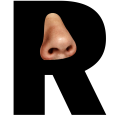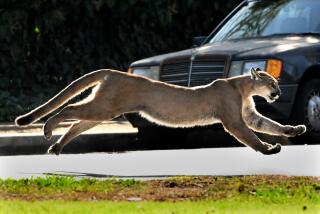
Running along the trails that whipsaw through the oak forests of the Palo Alto hills, I was hit with a musky, skunky smell that made the hair on my neck stand up.
I don’t know if it was a mountain lion, but something in the deep recesses of my brain told me to stop running, move slowly and keep my wits about me — all the while ruing the day I had become a vegetarian.
Suddenly and surprisingly, I found myself recalling an experiment my dad conducted in the 1980s when he tested the idea that animals — i.e. deer — could discriminate between the odors of meat-eaters and vegetarians.

Forty years later, I was taking my dad’s question in a new, situation-specific direction: Can a mountain lion, by scent, detect a vegetarian? And though mountain lions occasionally consume carnivores and omnivores, did I smell more like easy prey — i.e. breakfast — than a fellow predator?
My run ended as a walk and with no ambush. But the question took hold and made me reflect on my father and led me to weeks of reading articles and research studies and talking to scientists and experts on predation and scent.
I would learn that there is one particular animal that can discriminate between the odors of humans who eat meat and those who don’t — and it’s neither mountain lion nor deer.

I grew up in a small, woodsy — but tony — Hudson River Valley village 30 miles north of Manhattan during the 1970s and ’80s. And from about the time I was 10, I knew my dad was considered, well ... different.
There were the pelts of small mammals and birds that hung in our garage — and from which my dad scavenged to make fishing flies. And while most of my friends’ fathers commuted into the city, my dad’s office was in our house — which meant he was the parent waiting at the bus stop.
But it was the venison we ate all year long that really signified to me something was different in the Rust house.
On evenings and weekends, while other dads were playing golf or tennis, my father would don a zip-up, one-piece camouflage suit. He’d paint his face with brown, black and olive stripes and slip into the woods behind our house, compound bow under his arm, to hunt deer.

He was so well camouflaged that by the time he got three or four feet into the woods, he was impossible to see.
This was a problem for my brother and me, because we were allowed to watch only one hour of television a day. When my dad went hunting, we’d surreptitiously turn on the set — trying to get “I Love Lucy” and “The Carol Burnett Show” reruns — never knowing if he was standing at the edge of the woods watching us. Turns out, he occasionally was.
Trained as a psychologist, my father had carved out a career in children’s marketing, which occasionally necessitated a trip into the city. It was on one of these expeditions that my dad met up with a friend who told him about a weapons system he’d worked on during the Vietnam War called Project Batboy.
According to my dad’s recollection of the conversation, the system consisted of mechanical chemo-sensing devices that were designed to distinguish — in the field — between meat-eating U.S. troops and the largely vegetarian North Vietnamese.
I have not been able to verify Project Batboy, but did learn the U.S. built a chemo-sensing device called a “people sniffer.”

Deployed on low-flying helicopters, it picked up air samples, and via a chemical reaction to ammonia, an indicator of urine or sweat, signaled the presence of humans. The sniffer also could detect smoke, a sign of human activity. Once detected, the site was marked on a map, and carpet bombed that day, or the following morning. (Walter Cronkite once introduced a segment on the sniffer. You can watch it here.)
Apparently, it didn’t take long before the North Vietnamese figured out what was going on and started hanging buckets of urine in the trees to throw the Americans off their scent.
According to my dad’s friend, the Batboys took the people sniffer concept a step further — resulting in a device that could somehow discriminate between meat-eaters and vegetarians (which, like the people sniffer, occasionally singled out unsuspecting animals).
My dad said he didn’t think too much about the anecdote at the time, other than considering the horror of it all. But a few months later, as hunting season approached, it spurred an idea.
For years he’d wear not just camouflage clothes but artificial scents too — which he claimed really didn’t seem to work, but which hunters often use to lure or confuse their prey.
In an article for Sports Afield magazine in 1984, my dad wrote, “The challenge of hunting ... is the challenge of overcoming the deer’s sense of smell.” He had only two firm conclusions about artificial scents, writing that “1) If I smell like a deer, dogs will chase me, and 2) if I smell like a skunk, people will stay away from me.” (The same edition included an article headlined “Sex and the Single Hunter,” but that’s another story.)
He had noticed that deer seemed to spook if he was upwind of them. Was it because they could tell he was a predator by his carnivorous scent?
So began an experiment in which my dad became a vegetarian in the two months leading up to hunting season — a tactic he claims was wildly successful but which came to an end in 2007 after he got Lyme disease, a tick-borne illness that seems to target people who spend lots of time in the woods, for the sixth time.
His hunting days were over.

Olfaction is the most ancient of animal senses, said Catherine Price, a behavioral ecologist at the University of Sydney in Australia.
“Bacteria use it and basically every organism uses it,” she said.
They can use it to find food, avoid predation, and in the case of animals that have sex to reproduce, find a mate. In the case of deer, they use it for all three purposes. But did my dad avoiding meat fool the deer into thinking he was harmless? That’s not so clear.
“A lot of these hunting theories I call anecdotal,” said Carter Niemeyer, a retired federal and professional wildlife trapper who has used scents to lure animals for north of six decades. “His personal data told him that it was working for him,” he said of my father, “so I wouldn’t discredit him, even if I might be skeptical.”
As for my question of whether a mountain lion could tell if I was a vegetarian and then use that as data to decide whether to pounce — Niemeyer found that unlikely.
First of all: Mountain lions are visual predators, he said. My running, more than my scent, would have made me a target. Which isn’t to say mountain lions don’t use olfaction to find prey, he said. They probably do.
“It’s similar with bear attacks,” he said. “Like a grizzly bear attacking a hunter who’s gutting an elk. They suddenly sense that overwhelming odor of elk blood and come in for a look ... there’s that aspect of predators needing to identify what they’re attacking.”
Which is why when you’re out in the woods, especially in bear and mountain lion country, you should make sure to announce yourself with a “Hey, bear! Hey, bear!”
“Talk out loud, identify yourself, and allow those predators to kind of absorb the whole scene and all the humanness and help them realize this is not one of my usual prey items,” he said.
Humans probably smell, well, human to most wildlife — without fur, and with our sweat glands oozing at the surface, we’re a pretty stinky, or at least stunningly recognizable, creature. The relatively small differences between us (our soap choices, laundry detergent preferences and diets) probably aren’t super important or relevant.
Those additional smells are just noise sputtering around the one important signal, said Price, which is that we are human — and therefore indicating it’s time for that animal to run or hide.
That is, unless that animal evolved to feed specifically on us.
A few mosquito species feed only on human blood, for instance. They don’t like deer, dogs or cows. Just people. Apparently, they’re drawn in by odor.
Niels Verhulst, a researcher at the University of Zurich’s Institute of Parasitology, said it is the makeup and composition of the bacterial species we harbor on our skin that give us our odor. Some of that is determined by genetics, some from the products we use on our skin, and some from our diet.
“But how important these different parts are? That is something that we do not know yet,” he said, noting that there is a positive correlation between drinking beer and one’s attractiveness to mosquitoes.
But what is clear is that science has found only one species that can discriminate between human vegetarians and carnivores: Homo sapiens.
In 2006, Jan Havlicek, director of the Human Ethology program at Charles University in Prague, set up an experiment in which he got young, college-aged women (who were not taking hormonal contraceptives — which could theoretically affect a woman’s perception of scent) to smell a series of odor-infused swaths of cloth that had been worn in the armpits of similarly aged men.
The women were asked to rate the “pleasantness, attractiveness, masculinity, and intensity” of the sweat-infused samples. Turns out, Havlicek said, that they found the odors of vegetarians “more attractive, more pleasant, and less intense” than the meat-eaters.
A similar study was repeated 13 years later by a team of Australian researchers, who came up with slightly contradictory findings: The most pleasant aromas came from men who ate lots of fruits and vegetables. But it wasn’t the men who ate meat who had the lowest ratings. That ranking went to guys who ate lots of carbohydrates.
(Interesting side note: Those results mirror data showing that men who have yellower, more carotenoid-rich skin — a byproduct of eating lots of fruits and veggies — are also found to be more attractive by women.)
As for my dad? He never went back to his vegetarian days, although he eats a lot less meat than he used to. Which may explain the constant presence of deer eating the flowers and shrubs in my parents’ yard.
More to Read
Start your day right
Sign up for Essential California for news, features and recommendations from the L.A. Times and beyond in your inbox six days a week.
You may occasionally receive promotional content from the Los Angeles Times.








